Jump Ahead To
One of the most iconic parts of Japanese culture is the Samurai. These honor-bound warriors are as reliable as their sharp blades. Originally existing as military nobility and officer caste in medieval-era Japan, the term has grown to a broader meaning. It often describes sword-wielding warriors with a strict moral code. In anime, the presence of the Samurai in an anime or manga has often created the impression among fans. We often look for cool philosophical remarks and even cooler fight sequences.
So, what is the Best Samurai Anime?
Undoubtedly, it is Ruroni Kenshin with the best sword fight scenes and many riveting encounters. It has the highest rating of 8.32 in MAL, with an enduring fanbase since the first episode premiered in January 1996. Since then, Rurouni Kenshin has moved to more media. The latest being its live-action adaptation being a hit for the new generation of fans.
For new fans of the genre (and ChasingAnime), we have compiled 30 of the best Samurai anime for your next binge-watching session. We will keep it free from spoilers to and leave the stories and the twists for you to find out.
1. Rurouni Kenshin (Samurai X) (1996)
MAL Score: 8.32
It follows Himura, who used to work as an assassin. Now, he wanders around the countryside trying to help people with his sakabatou – “reverse blade sword.” His main conflict is reconciling his past with his present. It greatly demonstrates the extent that a man will go to in order to keep his oath.
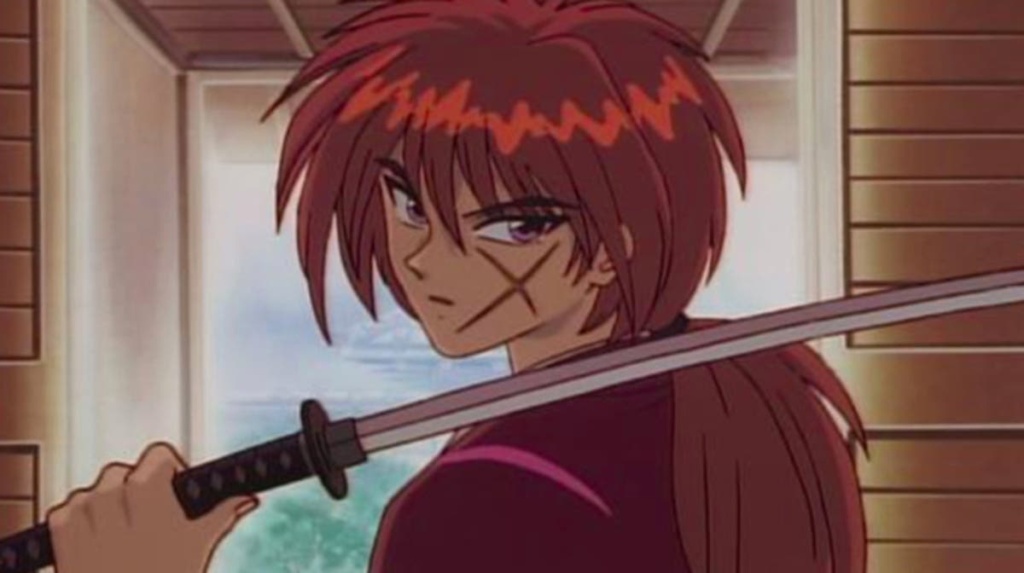
Over the series, you’ll be amazed at how close he got to dying several times in the series. Instead of shifting back to his Battousai persona, he commits to peace. It then clashes with the ideologies of the other characters, making the fights bear more gravitas. From men created by society’s injustices to people who blindly follow their beliefs – Rurouni Kenshin is more than flashy swordfights; it’s a treatise on what honor actually means.
It’s a perfect period tale – with action, romance, comedy, and even suspense at times. The short, clumsy wanderer is actually the legendary assassin everyone is looking for. Furthermore, it has an assortment of characters that also grow and develop over the series. We just can’t stress enough how much of a must-see anime Rurouni Kenshin is.
2. Sengoku Basara (Samurai Kings) (2009)
MAL Score: 7.41
For fans looking for samurai anime with over-the-top awesomeness, Sengoku Basara is a good place to start. Aside from its mostly color-coded characters, it has well-crafted character and weapon designs. It includes a horse turned into a motorbike of sorts, complete with what appears to be exhaust pipes. Basara even has a pirate-themed character who wields a giant anchor, and a Gundam – see it for yourself.
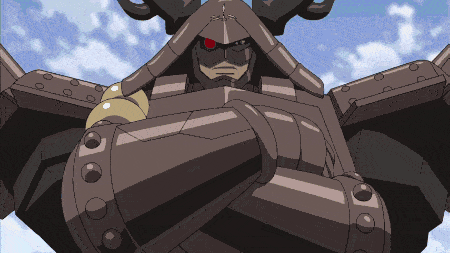
Its attempts to tell a balanced story across the different sides will leave you choosing your own team to root for. From the Takeda, to the Uesugi; the Azai, to the Maeda – each creates a distinct team you can bet on! Also, while the real history is a lot murkier, the anime makes their motivations a lot simpler. It varies from “conquer Japan,” to “serve my master faithfully,” “from defending my domain,” to “freedom.”
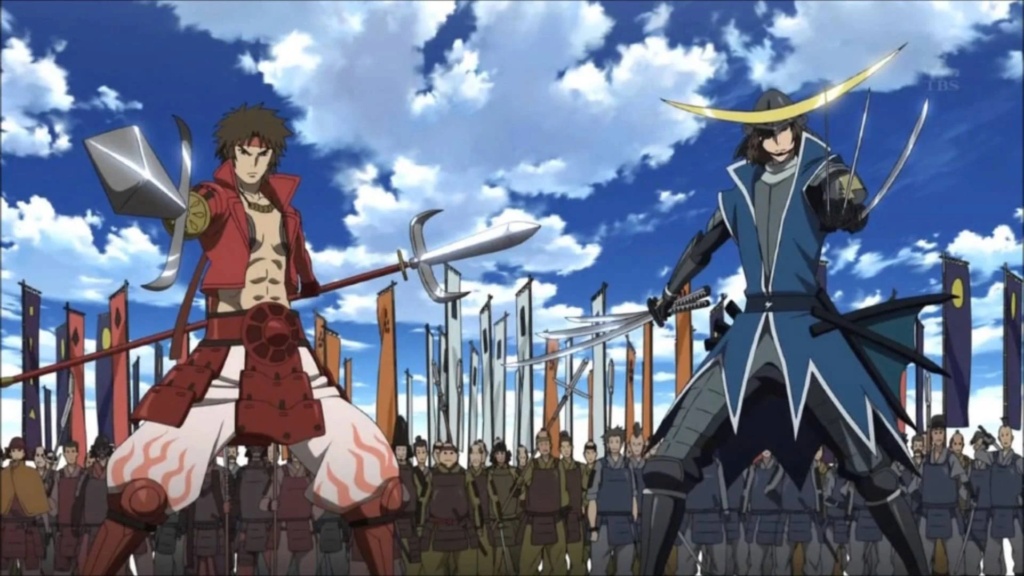
Sengoku Basara is quintessential Samurai anime, although slightly exaggerated. It focuses on the clashing ideals of the men who shaped the history of Japan. Each of the heroes is given enough time to fully flesh their ambitions should they conquer Japan. This is equally presented in their unique (though historically inaccurate) weapons which turns the awesome to max levels.
To the fans of the video game it was based on, the overemphasis on heroes is easy to accept. For some, it might appear weird as each attack from them sends ordinary soldiers flying in all directions. In some instances, it even appears comedic.
It makes for an epic wartime anime to binge watch.
3. Brave 10 (2012)
MAL Score: 8.62
In Japanese history, there was a group of legendary warriors that supported the samurai warlord Sanada Yukimura. Yep, the same source of the Yukimura above, and everywhere else in this series. Known as the Sanada Ten Braves, its most famous members have inspired countless characters in other anime. This includes Sarutobi Sasuke and Kirigakure Saizou.
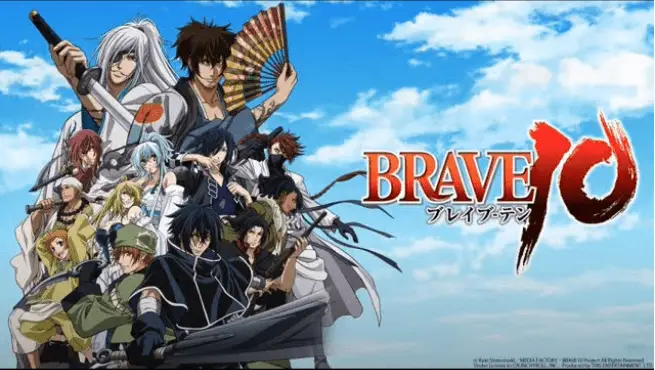
Saizou takes the lead role in the Brave 10 anime, rescuing Isanami, an Izumo shrine maiden. He takes her to find protection under Sanada Yukimura. Coincidentally, he is currently finding for members for a team with as many members as his fingers. Most of them are ninjas, as in real life, but portrayed here as a variety of different classes. This includes a priestess (Isanami), a monk (Miyoshi), a samurai/ Musketeer (Juuzou Kakei), and a pirate (Jinpachi).
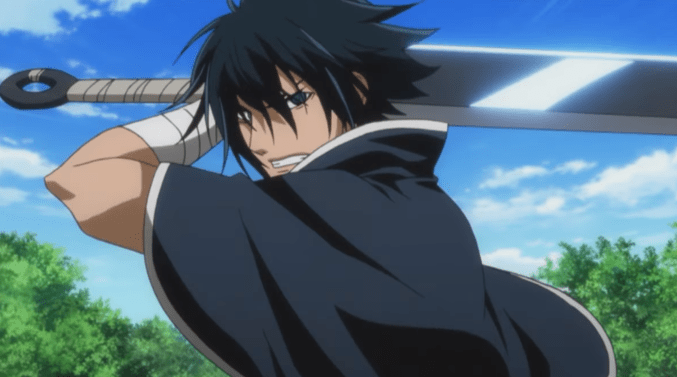
Brave 10 is filled with interesting character reveals, like Seven Deadly Sins or Fushigi Yuugi. Loose as it may seem, it actually boils down to Sanada’s Ten Braves protecting one of them- Isanami. It makes a fun experience of introducing us to new heroes, each with their own reasons for joining. While it does not delve deeper into each of their stories, it serves to break the ice (not just Anastasia’s) and make interesting fights.
Variety is the key in this series, even the art style that employs a variety of designs for its characters. This trick makes it perfect for first-time fans who are looking for a quick fix in the samurai/ period anime genre. However, the more experienced fans might dismiss it as “just another show.”
Our recommendation: watch it for a good time, however short.
4. Gintama (2006)
MAL Score: 8.97
We have mentioned Gintama before, focusing on one of its “mini story arcs” that shows a glaring example of Truck-kun, the infamous serial killer, mainly because we are among the fans of the seemingly anything goes anime. It is a caricature of the Japanese culture, government, and its industries – parodying famous people and other popular anime. However, when it needs to, Gintama delivers strong drama and action elements. It has made the anime adaptation a fan-favorite over the 12 years it ran on-air.
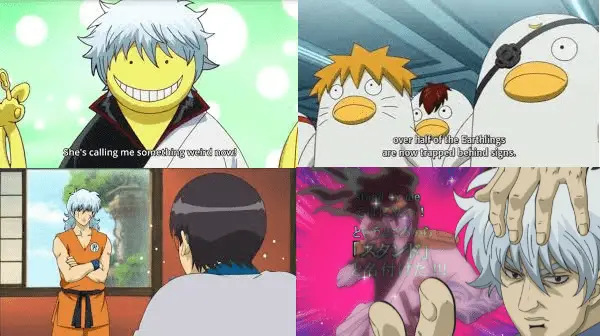
It follows an alternate history set in what was the late Edo period. Instead of foreigners flooding the formerly closed island country, aliens called the Amanto or “Sky People” invaded Feudal-era Japan. The Tokugawa shogunate becomes a puppet government and the samurai are banned from carrying swords.
Gintama is one of the best examples that captured the biggest enemy that the samurai has faced, real or fictional: change. The legendary White Yaksha reduced to an everyday guy who will do anything in exchange for surviving day-to-day life. Another example worth following in this series is Hasegawa Taizo, who becomes a running gag as MADAO. But still, as a former government official and a samurai, he knows when and how to stand his ground.
Its main strength comes from gags that seem to spare no one, even Japanese political leaders. Some of its jokes are universally funny, while others require a certain level of familiarity or at least a context of what their jokes are about. However, it does have a serious story to it. And when we say serious, we refer to something that rivals even Rurouni Kenshin in terms of intensity.

It is mostly a sitcom-type of anime, but when it introduces a story arc, it is sure to get you riveted. From a lot of dick jokes to philosophical discussions of social equality and honor, Gintama definitely deserves one of the top spots in this list.
5. Saraiya Goyou (House of Five Leaves) (2010)
MAL Score: 7.83
Originally aired sometime in 2010, Saraiya Goyou remains one of the most recommended samurai anime to date. It does not engage in anything grandiose, such as “glory” or “the strongest”. Actually, despite its Edo period background, it makes it relatable for people who are actually shy. It stresses finding acceptance and purpose in the most unlikely places.
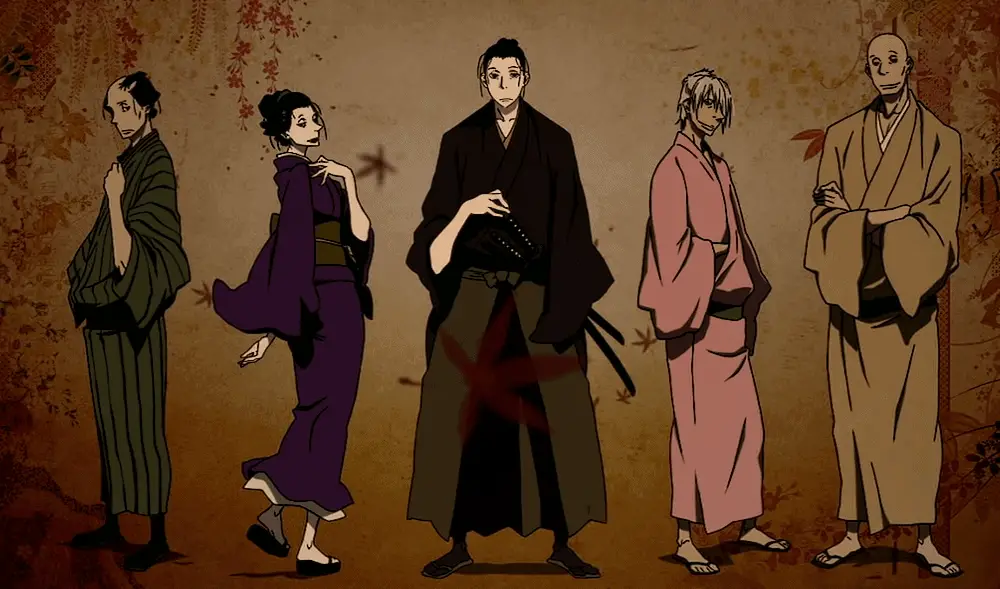
House of Five Leaves follows Masanosuke Akitsu, a former samurai released from his service by their town’s shogun. Despite his loyalty and his skills, his timid personality caused his dismissal. He later moves to Edo (Tokyo) and finds a job as a bodyguard for the titular group, the Five Leaves. Though he finds their activities illegal, he continues to work, mostly because of their carefree and enigmatic leader – Yaichi.
For a premise such as a ronin working for a gang, it does feel slow and makes the watching experience immersive. It’s just like you’re in the same, slow-moving scenes. The refreshing part is when it does not attempt to justify ideals or “honor” or “the strongest.” We enjoyed how characters like Akitsu just want to live their lives.

Also, as a curious fact, its author Saraiya Goyou is a well-known author of boys’ love manga under a pen name. This also translates well with Masa and Ichi’s relationship and subtle nudges at each other. Nope, we are not saying that this is a BL anime, at least not in the traditional sense. Five Leaves blur the lines because of its human and well-rounded characters.
6. Afro Samurai (2007)
MAL Score: 7.36
For such a simple story formula, Afro Samurai does excel at the points where its creator Takashi Okazaki focused. Intense action, cool and catchy one-liners, and designs that go perfectly well with its music. It was first adapted into a five-episode anime miniseries, and a sequel that brings the story full-circle.
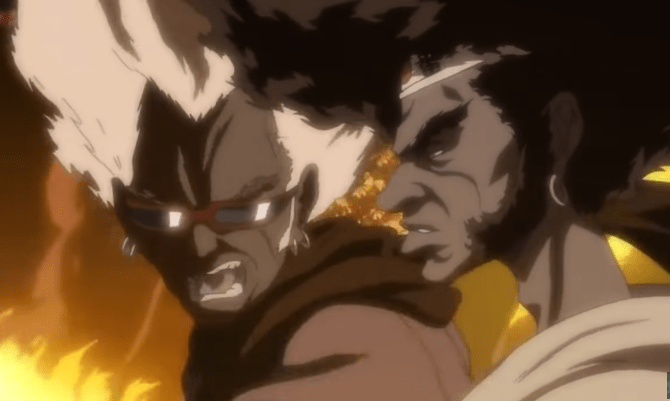
The story unravels against a backdrop of a feudal Japan, filled with futuristic tech and hip-hop music. Afro Samurai (yes, that’s his name, watch it ASAP) seeks revenge for the man who killed his father. He faces a number of adversaries looking for his Number Two headband. The owner of this band is the only man eligible to challenge the holder of the Number One headband.
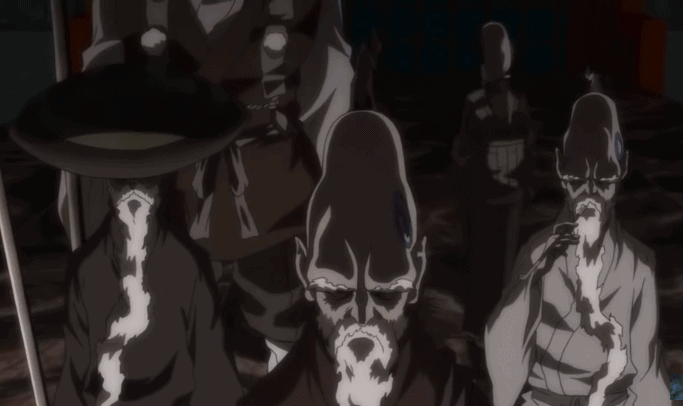
Read that again and see if it sounds crazy, that men die for a pair of headbands. However, the serious commitment of the characters to these bands, and the awesome fights that follow, will make you forget that silly premise. The story revolves around revenge, as it motivated Afro to a life of vengeance. Its sequel Afro Samurai: Resurrection, however, examines what lies after becoming the strongest and it’s for us to know and for you to find out.
A bit of warning though: Afro Samurai contains lots of blood spraying everywhere, hands and heads may or may not be included in all occasions. (And some mature scenes too.)
7. Mushibugyou (2013)
MAL Score: 7.37
Mushibugyou is one of the good anime, not just samurai anime, that you probably never heard of. It was a part of the Spring 2013 line up, easily sent under the radar by its peers that included Shingeki no Kyoujin, Hataraku Maoh-sama, and Date-A-Live. Either way, as evidenced by its MAL Score, it is an easy favorite for those who saw it.
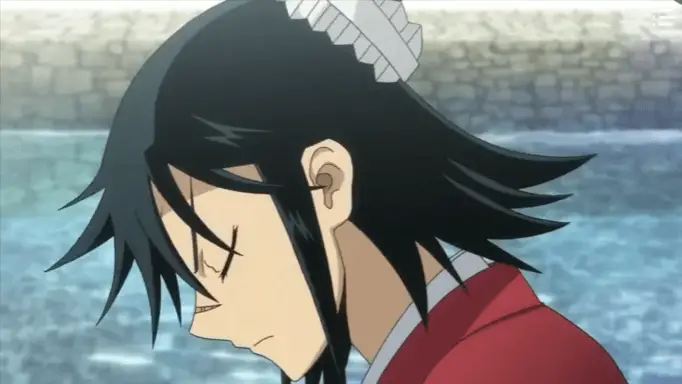
Set in an alternate feudal-era Japan infested with giant insects, we are introduced to the young Jinbei Tsukishima who went to Edo in place of his father (like Mulan). His determination and unyielding spirit makes up for his lack of skills at first. Together with his teammates at the City Patrol, they protect Edo from the monstrous man-eating insects.
To give a straight opinion on Mushibugyou, it’s a typical action shounen samurai anime. It doesn’t pull you too much into its world, nor into its story. But what it does have, it presents well – fanservice and action. Perhaps the most interesting part to follow is Jinbei’s progress as a warrior, starting with his earnest desire to take responsibility to what happened with his father.
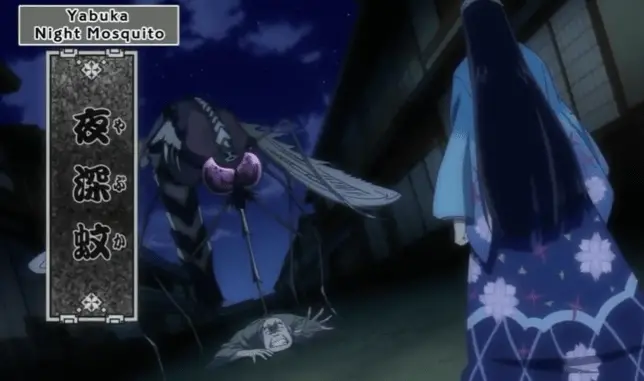
Its action is a hit is largely thanks to its series antagonists – the insects. They are not cartoon-y, and they’re not too monstrous in design. Although it has a monster-of-the-week type of presentation, they approach each differently, and even sparks flashback or spur-of-the-moment character development. Not bad!
8. Samurai Champloo (2004)
MAL Score: 8.50
We believe it is important to put it out here: the Samurai Champloo anime was directed by Shinichiro Watanabe, who also directed Cowboy Bebop. It has an episodic storytelling style, a good mix of different genres, and of course, great music. Samurai Champloo is among the top entries in the list and for a good reason.
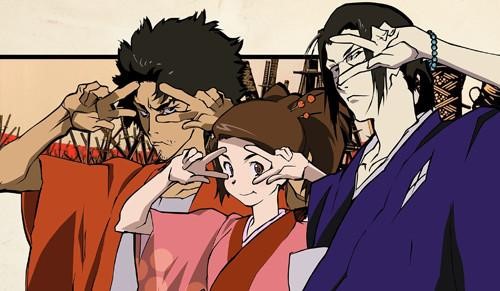
It follows a brave girl, Fuu, who is looking for the “Samurai who smells of sunflowers.” Accompanying her are two drastically opposite characters – the carefree, brash, and womanizing vagabond Mugen and the calm, reserved, and stoic ronin (masterless samurai) Jin.
While it is also set during the Edo period, some 60 years after the Sengoku period, it mixes historical elements with modern ideas. One of the most prominent elements in the series is the use of hip-hop music – even Mugen’s unconventional fighting style is mostly based on breakdancing. On the other hand, its story heavily features real-life characters and events – from Jin’s eyeglasses, to the Shimabara Rebellion, to references to Miyamoto Musashi and Vincent Van Gogh.
Their different characters work flawlessly, and to see them meet at one point and go in different directions again is kind of the thing that lingers after you watch it. The two swordsmen, while opposites in their ideologies, learn to work as a part of a team and learn to fight for another. Even Fuu, the trio’s voice of reason and the glue that holds them together, becomes a better fighter herself. By the end, it feels like a short journey between strangers, with each of them leaving stronger, wiser, and kinder.
A bit of trivia: Champloo in Samurai Champloo comes from the Okinawan term chanpuruu, a stir-fry-dish including bitter melon. It can also mean “to mix,” turning the title into something like Samurai Remix, which makes it many times cooler.
9. Samurai 7 (2004)
MAL Score: 7.50
In Japanese film, and in fans of everything samurai, the 1954 movie Seven Samurai by Akira Kurosawa is a must-see – having been adapted into numerous works both in Japan and in other places. The 2004 anime Samurai 7 is its steampunk samurai anime adaptation.
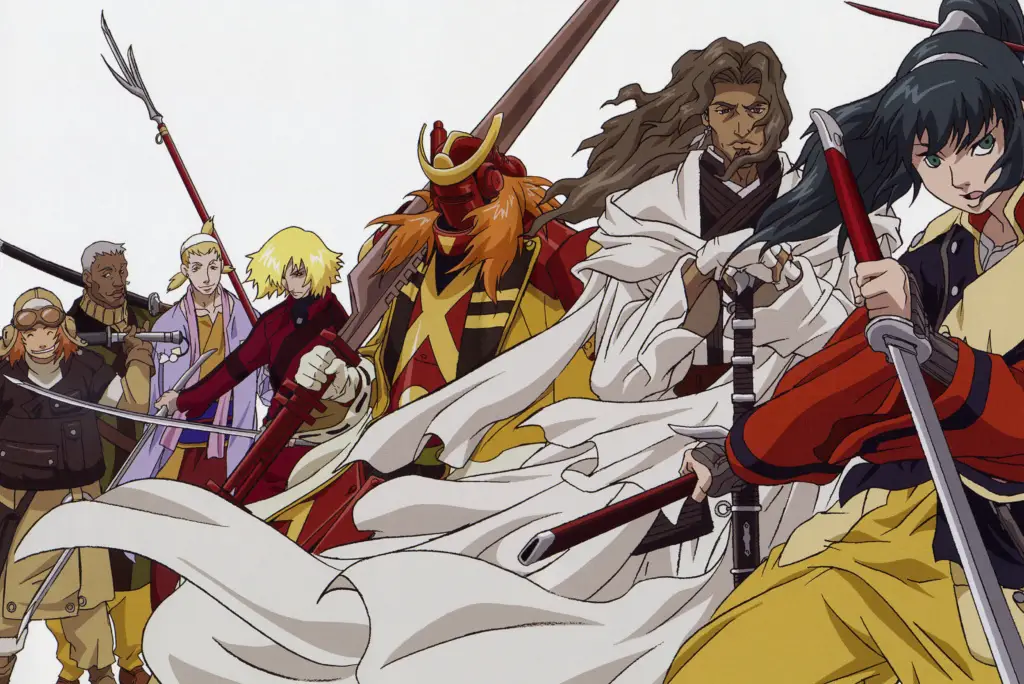
Set in a futuristic world, with spaceships and mechas, mechanized bandits called the Nobuseri terrorize and steal from a small farming village. The villagers send representatives to find brave and skilled samurai who will defend their village from the bandits. With only rice as payment, they were able to recruit samurai different from what they expected. A total of seven warriors would commit to the cause and change history forever. It closely follows Kurosawa’s film story-wise. However, the visuals allow for more liberties in the character designs, making them stand out more from each other.
Its David vs Goliath difference is shown between outgunned and outnumbered Samurai versus bandits. This only serves to bring that “awesome Samurai skills” to the forefront. However, a closer look actually examines how men, guided by their different principles work together toward a seemingly impossible goal. It varies: personal pride (Kikuchiyo), recognition (Katsushiro), or respect for an opponent (Kyuzo).
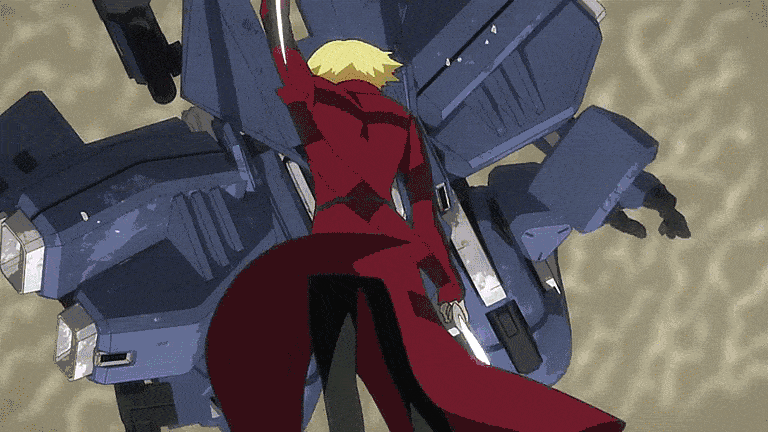
The seven titular samurai all face equal odds of surviving and dying, as you will see in the series. It also asks important questions and even takes most of the good parts of the original story – like its own definition of a samurai. The story takes place after a great war, most warriors now lend their skills to who can pay them. For small people in need, who can only pay with the only thing they have – rice – it’s interesting to see the types of characters who will join them.
“So. Again we are defeated. The farmers have won. Not us.” – Shimada Kambei.
10. Hakuoki (Demon of the Fleeting Blossom) (2010)
MAL Score: 7.43
Another welcome entry that features the Shinsengumi – Japan’s former elite police unit. This time, with Hakuoki, they are the focus of the story. While most of the characters are fictionalized versions of real samurai, the story is entirely fictional.
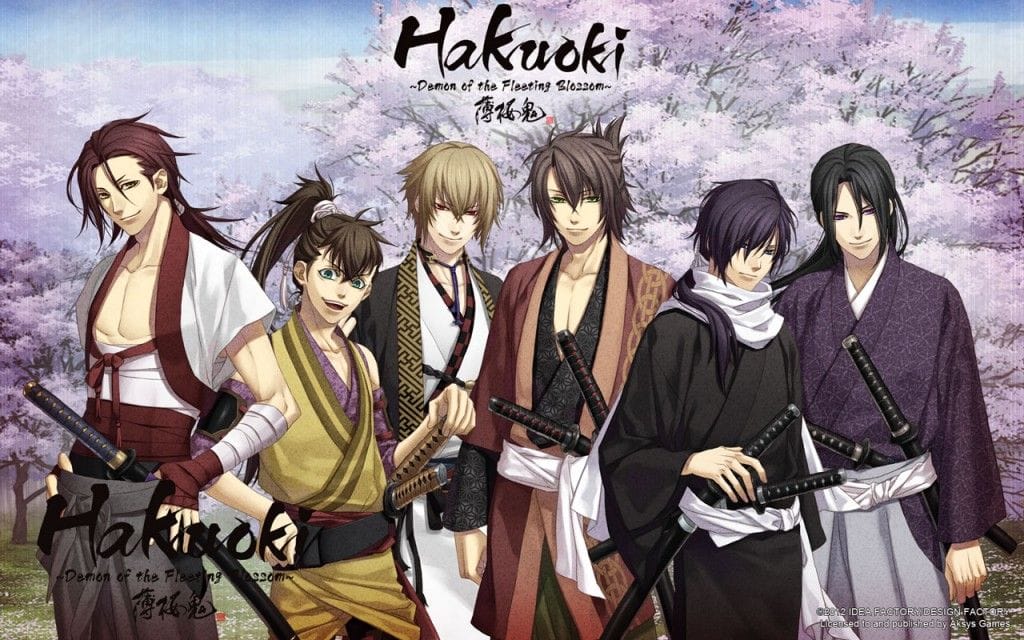
It follows Chizuku Yukimura, who disguises as a boy to get to Kyoto in search of his father. She was chased by a ronin, who were in turn attacked by zombie-like creatures called furies. Before she gets into more danger, members of the Shinengumi arrived.
The close-knit bond between the members of the Shinsengumi is evident in the series. Most of them are young men who moved to the capital from the province. Others do not even coming from Samurai classes, is evident in the series. Their closeness, often mistaken for something else, shows how camaraderie and trust in their “brothers” have become an important part of their troop. Together, they protect each other’s life and honor, whatever the foe may be.
Hakuoki is an anime based on the story-based video game of the same name. This takes the story of the Shinsengumi and follows them where furies are a literary analogy for something else – change. It mostly illustrates the secret police as the grapple with the changing Japanese society. With the Western forces imposing its ways and values and pushes the way of the samurai into obscurity.
11. Basilisk: Kouga Ninpou Chou (2005)
MAL Score: 7.59
Basilisk: The Kouga Ninja Scrolls is a 2003-2004 anime based on a manga published some months earlier, which in itself is based on a 1958 novel of the same name. It is a Romeo & Juliet story between two rival ninja clans. While it technically focuses on ninjas, the samurai plays an integral part in the story.
It is set against the Azuchi-Momoyama period, or the late 16th century near the end of the warring states period. The Iga and Kouga ninja clans were first forced into a ceasefire by the shogun Ieyasu Tokugawa. Their heirs, Oboro and Gennosuke are betrothed to each other in the hopes of uniting their clans together. Their hopes, however, are dashed when their clans are put against each other’s throats. This, also, is nothing more than a political struggle to succeed Ieyasu.
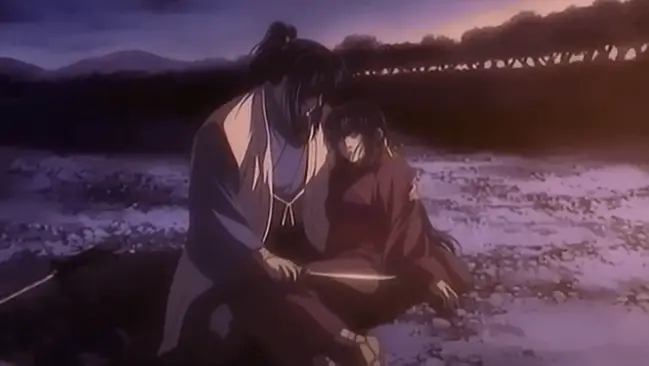
While its story is straightforward, it is definitely more action-packed than the Shakespeare story it was supposedly taken from. Also, it doesn’t waste any of its runtimes on running gags of fanservice, devoting its narrative to serious interactions and impressive fight scenes. As a result, it becomes a tense and fast-paced story with a lot of action and intense politicking – like an anime version of Game of Thrones (the first few seasons, you know).
Fair warning: some reviews have described the story as “depressing.” Its story, in an attempt to reflect the political turmoil involved, seems to lead nowhere – marked by continuously increasing death toll from both sides. It moves the story forward, regardless of who dies, as everyone looks at equal chances of dying.
12. Blade of the Immortal (2008)
MAL Score: 6.82 (2008)/ 7.35 (2019)
First off, the anime adaptation of Blade of the Immortal has largely toned-down from its manga source in terms of gore as well as in the details. Having said that, it still managed to earn the approval of fans, leading to the MAL Scores you see above.
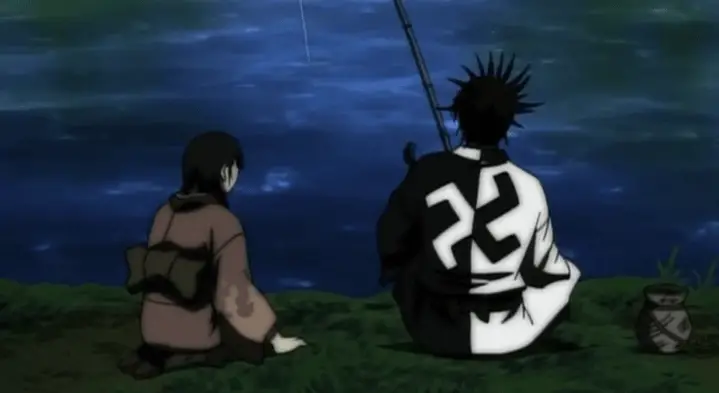
It first became an anime back in 2008, with the story recapped and continued in 2019. The story introduces us to Rin, who is seeking revenge for his father. She then enlists the help of a skilled ronin Manji who is cursed – he is basically immortal. Through “sacred bloodworms,” Manji can recover from almost any wounds, from headshots to severed limbs.
Manji the immortal is mostly focused on his quest of killing a thousand evil men. It has similarities with Oldboy – with Rin confused and surprised as to why her family had to die for something like revenge. Revenge, in its different faces, move the story of the characters and ask the audience what will they do if they were in those scenarios? One of the more interesting characters, Taito Magatsu, is a full tale of revenge – from helping to assassinate Rin’s parents to watching his own beloved get killed – you should see.
As a samurai anime, Manji’s assortment of unconventional weapons takes top spot on why you should watch it. The next is its different characters. It has a charismatic Kenshin Himura-type antagonist. “Blade” also features sick psychos like Kuroi Sabato who has three heads. Watch it to see what we mean.
13. Hyouge Mono (2011)
MAL Score: 7.99
Since samurai anime is often connected to action, Hyouge Mono is the only one of its kind on its list, if not in the entire genre. This is one of those anime works that, in its originality, stands by its story and might alienate some fans. It fuses comedy and drama into a historical series. This way, it drives an appreciation for the arts as well as asking philosophical questions along the way.
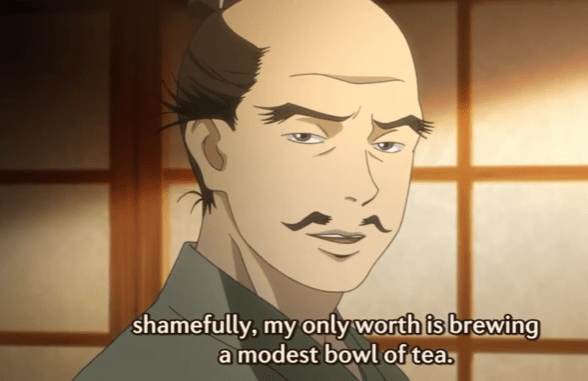
During Japan’s warring states era, Oda Nobunaga has a vassal named Furuta Sasuke who loves the traditional tea ceremony. Sasuke finds his purpose in knowing everything there is to know about the art. As a vassal under Oda, he later learns from the most influential tea master Sen no Soueki. It leads him to face the conflict between his military career and his passion for tea ceremony as the Hyouge Mono.
While comedic at times, Hyouge Mono is serious in delivering its themes for discussion. One point made clear is its version of whether “less is more” – illustrated when Toyotomi Hideyoshi creates a gold-decked mansion while Rikyu makes a tiny teahouse instead. It also focuses on wabi – the acceptance of imperfection. It was a refreshing experience to see this anime regularly discuss the view of beauty as being imperfect and incomplete. Through this, regularly “displeasing” factors like simplicity, asymmetry, and lack of balance appear as necessary elements to achieve beauty.
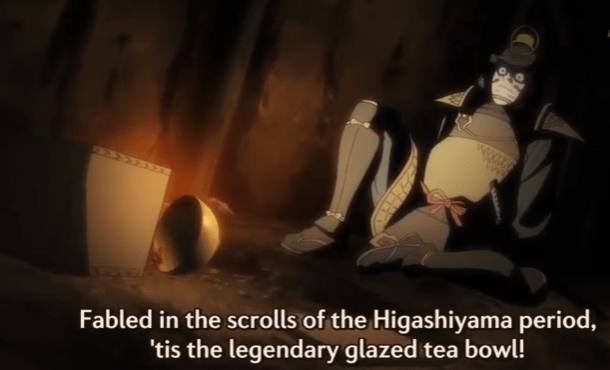
Though set in a time of wars, Hyouge Mono manages to create a world in the same period that focuses on beauty and complexity. It is exemplified in something like the tea ceremony, and its relation to larger things in life. You know this anime is something else if it can deliver a high MAL rating for a boring topic like tea. If you can get pass its slow pacing, it will be as rewarding as watch steins gate to the end.
14. Shigurui: Death Frenzy (2007)
MAL Score: 7.42
When anime try to work towards realism, in design and in motion, its violent scenes only become more as compared to those that deliver gore in an exaggerated art style. This is what sets Shigurui apart from most entries in this list. It mostly narrates the story of how cruel and unpredictable fate drives the lives of people.
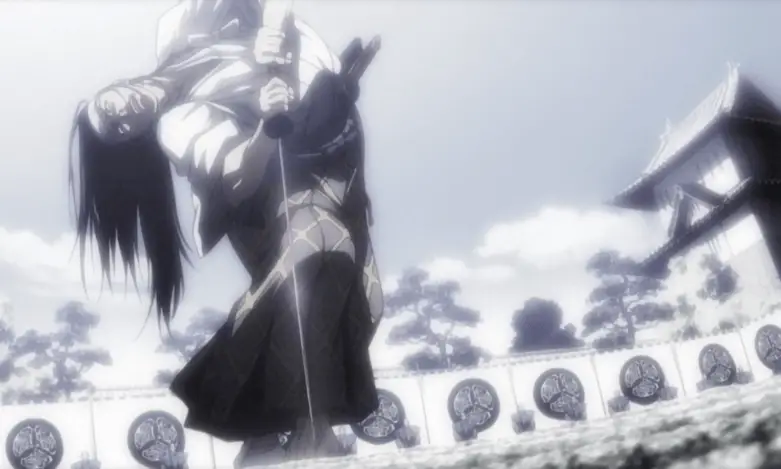
The anime starts with the then-shogun Tokugawa Tadanaga announcing that he would like to see a tournament. In it, the participants use real steel katana instead of the wooden swords. In the first match, we see Gennosuke Fujiki – a swordsman with only one arm. He is pitted against the blind swordsman Seigen Irako. As the audience wonders about this duel, the story jumps to a flashback to when the two first met.
In watching Shigurui, we strongly advise two things. The first is to work through the first four episodes. Second, if possible, watch the entire 12-episode series in a short interval (binge-watch if you can). Shigurui leaves an empty feeling when it ends, mostly because most of the time, events happen though people never really understand why. Its two characters, Irako and Fujiki, depict two contrasting ways of fighting and surviving against a cruel society. We won’t spoil, but we believe that their respective disabilities seem to symbolically represent their character development.
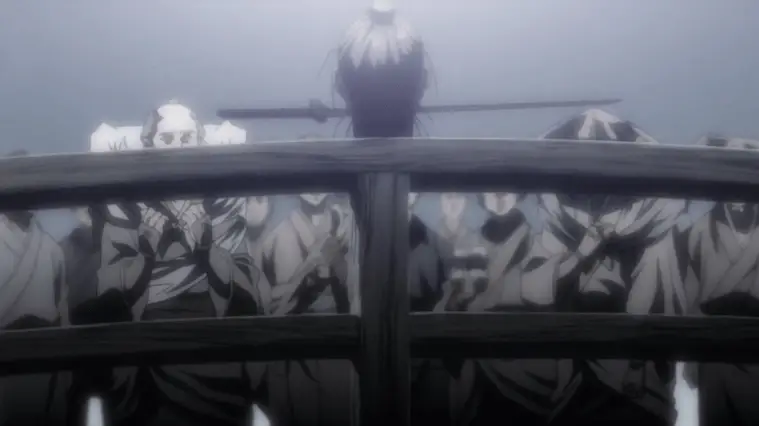
In portraying uglier sides of the Tokugawa period, it comes as a treat for fans of the samurai genre. By following the circumstances that brought Fujiki and Irako to the duel, it draws the audience into an odd experience.
Also, please don’t ask us who won in the fight – the one-armed man or the blind one.
15. Stranger: Mukou Hadan (Sword of the Stranger) (2007)
MAL Score: 8.32
It is an animated movie with a total runtime of less than two hours. Having said that, it works both as a quick fix for your adrenaline rush. We can also say that it is a candidate for one of the best action anime films in recent memory. Its lack of a complicated plot works in allowing the audience to focus on its well-animated fight scenes. It also emphasizes as well as the bond between its main characters.

Sword of the Stranger immediately gives us a taste of its fight scenes’ caliber. Shortly after, we see Kotaro and Tobimaru scavenging food from a nearby village. As their pursuers from the Ming Dynasty follow them to an old temple, the wandering Nanashi defends the dog and the boy.
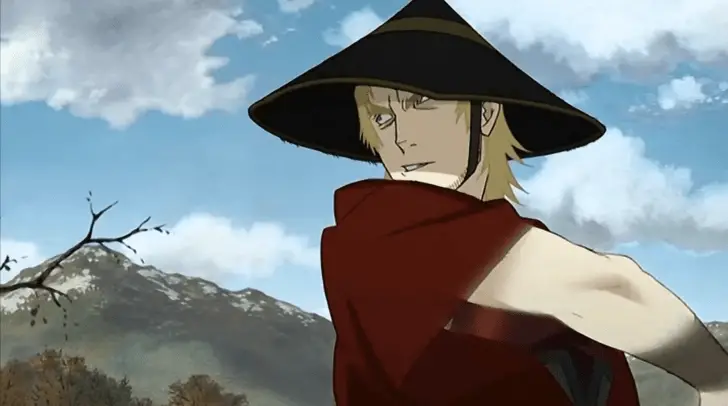
One of the biggest questions is why the Ming and the warlord so intent on chasing a small boy. But by the time it is answered, it feels nonsensical and unfair to the innocent kid. It just shows how unfair life is for small people like Kotaro, caught in the schemes of powerful people. One of the best fight scenes in this list is the final confrontation between Nanashi and Luo Lang – the skills we perceive they have, built over the entire series, explode in this epic confrontation. It was further emphasized by the fluid animation that feels lifelike at times.
While the unlikely bond between Nanashi and Kotaro is a tale most of us have heard before, the movie still manages to make it work between them. It leads to an unending that teeters between two of the usual endings with these kinds of stories. Also, like most Samurai works, it also pits Nanashi with a near-undefeatable monster – his past, and how he tries to redeem himself, at the point of self-sacrifice. Whether Nanashi, Kotaro, or Tobimaru survives till the end is for us to know and for you to find out.
16. Dororo (2019)
MAL Score: 8.18
Dororo is a manga series written and illustrated by The Father of Manga himself. It is a Osamu Tezuka work, who also created classics Astro Boy and Black Jack.
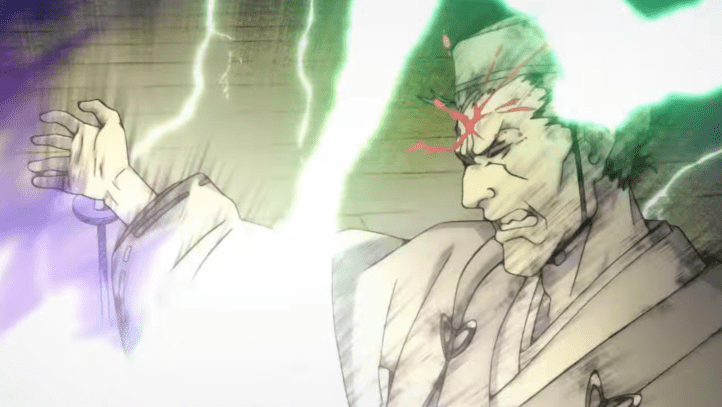
Sure enough, it bears resemblance to either work. Like Astro Boy, the main antagonist in this series is the father of the main character. Lord Kagemitsu Daigo, just as his wife is about to give birth, strikes a pact with demons in exchange for power. The price for his wish was his son, who was born without limbs, skin, or even facial features. He was saved, and through alchemy and prosthesis, was able to survive into the warrior Hyakkimaru. He later found a small child, Dororo, and together they journey across the war-torn countryside and kill demons.

One of the most impressive parts of Dororo, despite being a 50-year-old story, is that Dororo tackles the disparity between genders. She does not dress femininely and actually prefers to be a boy, explaining that it would be easier to survive as one. In fact, Dororo’s gender was only revealed in the ninth episode. It was a surprise to some of us who didn’t know of the 1969 adaptation.
Also, both versions used its dark fantasy world to better emphasize what it means to be human. Hyakkimaru started out with basically none of the normal senses we have, aside from a specialized “sixth sense” of sorts, in exchange for his father having “everything.” Over the course of the story, he defeats the demons and slowly becomes “human.”
17. Drifters (2016)
MAL Score: 7.96
We have featured this anime before, in our list of the best Isekai Anime. However, our previous write-up focuses on its strength as an isekai series. Drifters by Kouta Hirano, who also created Hellsing, also works as a samurai anime.

Its main character, the fearless devil-may-care Toyohisa Shimazu is a warrior in the fictionalized Battle of Sekigahara. As he is transported to the other world, we are introduced to other historical Japanese warriors. It includes Nasu no Yoichi, to Oda Nobunaga and Hijikata Toshizo, to Naoshi Kanno.

In fight scenes, there’s really no artistic exchange of blows as in other samurai anime in this list. It’s an all-out war. Even its graphics seem to be specifically designed to bring that gritty no-nonsense experience to the audience. It remains a prime example of how war is not black and white. History’s heroes and villains, in a battlefield, are just men and women off to defend what they believe in. As Drifters take the characters and turn them to opposite sides, it manages to make sense – that war does not discriminate.
Also, for new visitors of our page, that the enemies in Drifters are those that history has deemed as heroes. This includes from the former Shinsengumi vice-commander to Joan of Arc who is a Catholic saint in real-life. Lastly, the anime heavily hints that the Black King is Jesus Christ. But is it? For Chasing Anime, this is a question that we have been waiting for since the anime came out.
18. Juubee Ninpuuchou (Ninja Scrolls) (1993)
MAL Score: 7.62
If an anime boasts being one of the most influential films ever made, on par with Akira and Ghost in the Shell, would you watch it? Heck, even the Wachowskis themselves admit taking inspiration from this film and influenced The Matrix franchise. These are among the praises Ninja Scroll keeps, despite being a 1993 period drama slash sword fighting anime film.
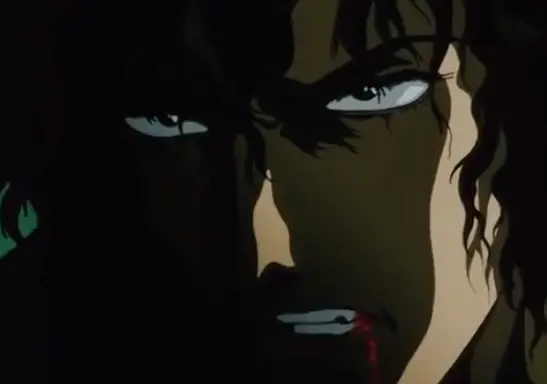
Basically, the premise follows the wanderer Jubei Kibagami rescues a woman from a supernaturally-powered ninja. He finds himself embroiled in the task to kill the remaining members of “The Eight Devils of Kimon”. Along the way, he unravels a link to his past. It will explain why he ended up as a wandering swordsman for hire.
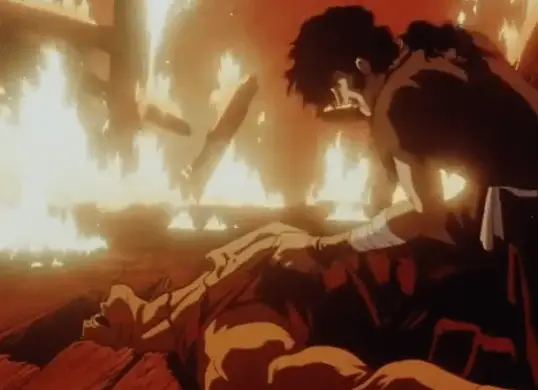
Its story escalates from a basic damsel in distress scenario to a massive conspiracy plot with a twist. Ninja Scrolls keep you glued to the edge of your seat with its energetic maneuvers. It is choreographed and animated well, emphasizing the focus in this early 90s work. These fight scenes further outdoes itself with the variety of the enemies that Jubei face. It varies designs, from the huge guy Tessai to the lithe woman Benisato.
Also, the Ninja Scrolls has regular frontal nudity and copious amounts of blood scattered about. If you’re looking for a classic, with art styles reminiscent of Fist of the North Star with top-notch fight scenes, Juubee Ninpuuchou is a good place to start.
19. Mutsu Enmei Ryuu Gaiden: Shura no Toki (Time of Shura) (2004)
MAL Score: 7.59
Equal parts Jojo’s Adventure, Rurouni Kenshin, and maybe Kengan Ashura or Baki. Mutsu Enmei Ryuu Gaiden: Shura no Toki has earned admiration from martial arts practitioners themselves. Like Jojo, it also follows multiple generations of a family, bearing the same name and martial arts. As with Kenshin, Baki, and Kengan, it often follows an unlikely wanderer finding himself at odds with the strongest of their respective eras.
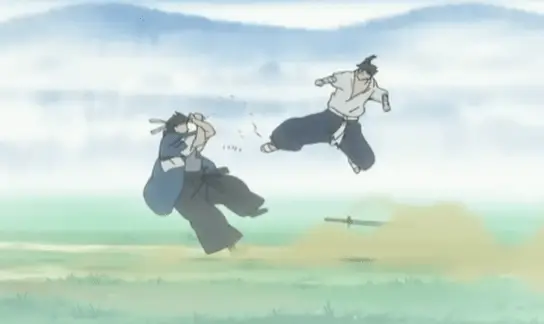
The first arc follows Yakumo Mutsu. He impresses the legendary Musashi Miyamoto by fighting him on equal footing, entirely unarmed to boot! Yakumo fights barehanded with a martial arts style called the titular Mutsu Enmei Ryuu. The second arc follows the next Mutsu who participates in a martial arts tournament. The third, and is the most plot-driven according to fans, takes place during the Meiji Revolution. This follows the third Mutsu, who faces the Shinsengumi vice-commander Hijikata Toshizo.

Aside from obviously illustrating that one can’t be judged based on appearances, Shura no Toki also takes the time to tell us how respect goes a long way. Even in the face of strong enemies, changing times, or even defeat, an honorable person always lives his life with as much pride and nobility as he can. Even during the fight with the gravely ill Okita Souji, Mutsu says that it was not him who defeated the genius swordsman, it was his disease.
Also, the series featuring historical characters adds a layer of depth to the story. Our personal pick: the fight between Mutsu and Okita Souji, the legendary boy genius.
20. Fuyu no Semi (Winter Cicada/ Embracing Love: A Cicada in Winter) (2008)
MAL Score: 7.55
Again, like Drifters, we have previously written about Fuyu no Semi. From a different standpoint, but we mostly focused on its strengths as a boys’ love (BL) anime. As a samurai anime, it mostly focuses on their lives and challenges they faced as warriors and men in changing times. It’s not an action anime as much as it is a tragic romance. Fuyu no Semi is also a sociopolitical examination of the early Meiji period. It was at a time when Japan has just opened its port to the world.
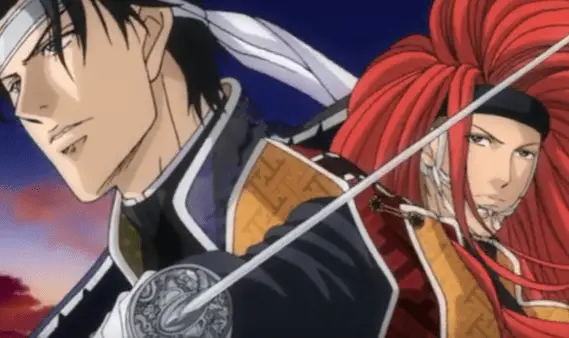
Although it does not strictly follow the source material that is Youka Nitta’s Embracing Love manga, it brings to life the story in its own three-episode OVA format. It features Keiichirou Akizuki, who works for the Tokugawa shogunate, and Touma Kusaka from the Choshu clan that strongly promotes an exclusionist policy.
There are not a lot of fight scenes in Fuyu no Semi: they are actually few and far between. Despite the lack of one-on-one samurai fights, it does create a compelling retelling of the wars that occurred during the Meiji Restoration, if only in a slideshow format.
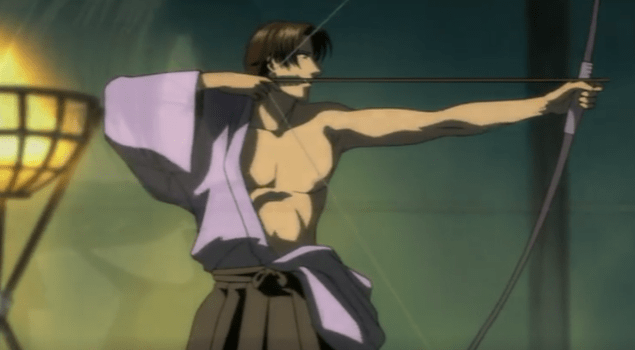
Aside from the forbidden love they share, it also probably captures the conflict among the Japanese youth at the time. Do they close their country or do they adapt to change? Kusaka has the opportunity to study in Europe, but is torn by the civil war in Japan when he returns. The challenge has always been to choose between preserving the ways of life they have against adapting to the inevitable change.
Lastly, we would like to stress its witty and snarky dialog. Another case in point, first episode, “Is that thing hanging from your waist just a decoration?” Swords. They talk about swords.
21. Peace Maker Kurogane (2003)
MAL Score: 7.34
In a good mix of fact and fiction, Peace Maker Kurogane is equal parts artistic fight scenes and tense storytelling. Kurogane, however, mostly goes through its episodes in a comedic slice-of-life kind of way, or life during the feudal ages of Japan.
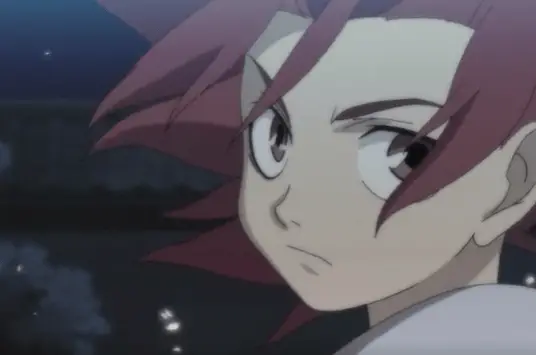
It follows the fifteen-year-old Tetsunosuke. He earnestly wants to join the Shinsengumi to avenge his parents who died before the series. Supported by his pacifist brother who joins as an accountant, Tetsu only wishes to become a strong soldier. He grows within the police force and works with its members, including its historic unit captains: Hajime Saito, Toshizo Hijikata, Souji Okita, and more.
Despite all its talk of Tetsu becoming a “Peace Maker,” the series does take its character conflicts and deaths seriously. For a fifteen-year-old kid, seeing death in front of him reignites his traumatic experience. However, to see Tetsu steel over this experience (get it, tetsu = steel?) is obviously painful and challenging. This becomes the important question throughout the show – if a kid would actually become a demon in the name of revenge. Their differing reasons for “becoming a demon” makes Tetsu and the rest of the Shinsengumi human, instead of flat-out characterizations of stereotypes or ideas.
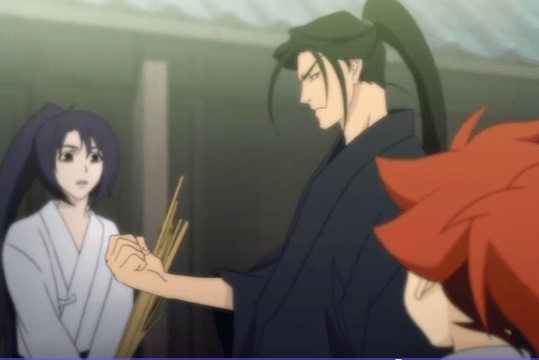
For veteran fans of the genre, the characters are already too familiar. But it doesn’t take away anything from Kurogane, taking its own pace at developing most of them.
A good summary comes from “The Demon Vice-Commander” himself, “The only thing you’ll learn here is how to be a demon.”
22. Samurai Deeper Kyo (2002)
MAL Score: 6.93
So far, Samurai Deeper Kyo has one of the most unique takes in the samurai anime genre. If anything, it seems to be closer in concept to the Onimusha game series – a mix of Rurouni Kenshin and Gensomaden Saiyuki of sorts.
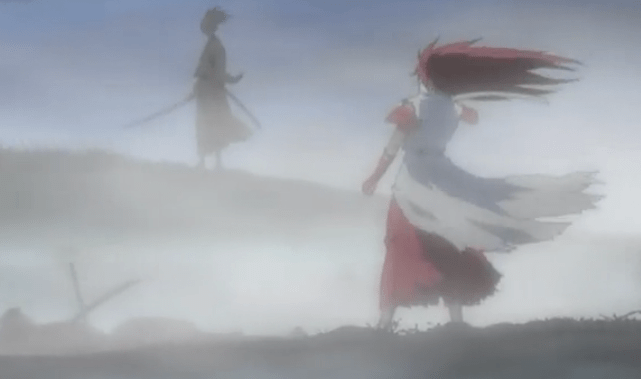
The story follows Shiina Yuuya, a bounty hunter looking for her brother’s killer. He then finds a young and kind medicine maker called Kyoshiro Mibu. However, inside Kyoshiro is the soul of his rival and enemy, Demon Eyes Kyo. Together, with an assortment of other characters, they find Shiina’s quarry, Kyo’s body, and the secret behind the Mibu clan.
The main challenges are better fleshed out in the manga, only lightly touched by the anime. As a man, the story later finds Kyo to face the truth about his and his clan’s origins. One character, the Crimson King, was a formerly benevolent king who lost faith and humanity and moves to destroy them instead. Given his experiences, his actions become questionable at best and downright evil at worst.
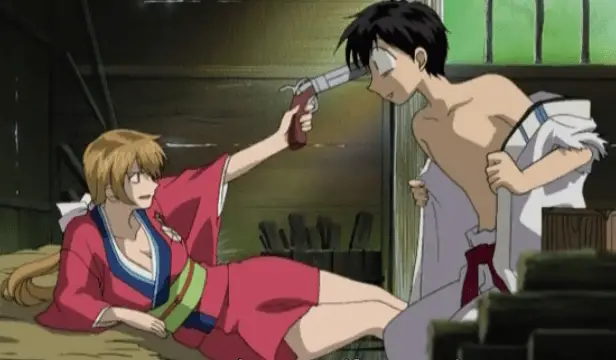
However, it wasn’t able to entirely adapt the manga, it only chose parts and fragmented story arcs from the source material. But for fans looking for samurai-slash-magic-tech fight scenes, Samurai Deeper Kyo can sufficiently provide what you need.
23. Hyakka Ryoran (Samurai Girls) (2015)
MAL Score: 6.82
Ok, let’s address this right off the bat – there seem to be different opinions about this anime. There are those who either love or hate the gratuitous fanservice across this 12-episode samurai anime series. Also, there are those who are aware that this stemmed from a light novel series in commemoration of Hobby Japan’s 40th anniversary. HJ is a Japanese publishing company that owns a number of publications and games and merch. So, yeah.
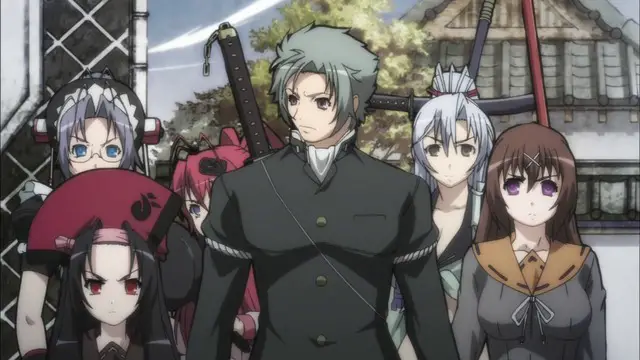
Samurai Girls take place in an alternate version of Japan – Great Japan – where the Tokugawa shogunate never went away, Japan still lost World War II, and now have American bases in its southern part. Children of esteemed families train their kids to be samurai warriors at a school, creating the roster of characters mostly descended from famous warriors in Japan’s warring states and the early Edo.
One point that is not that open for contest is the quality of art. Say what you will about the storyline, or the excess (or lack, thereof) of fanservice, but it has some seriously done artwork. Right off the bat, we see the samurai take down fighter planes by themselves in an anime/ ink art style. It creates a sense of otherworldliness and grandiosity for the rest of the series. Samurai Girls also weaves its story with explosive fight scenes. While it does play its fanservice card for laughs at times, it does not actually get in the way of the storytelling and the fighting.
Furthermore, despite its fanservice (we’re putting a nips/ butts disclaimer here), each of the samurai girls have their strengths and significant contribution to the story. For a sensible harem anime with good amounts of fighting and display of the samurai culture, Hyakka Ryoran is a great quick watch.
24. Touken Ranbu (Hanamaru) (2016)
MAL Score: 6.82
This one is especially aimed for fujoshis out there, a series of all beautiful… swords come to life? Based on the hit mobile gacha game by Nitroplus and DMM, Touken Ranbu has a pretty interesting premise. And while I never got to play the video game, not available in our area, I got introduced to the anime through another medium – Nendoroids.
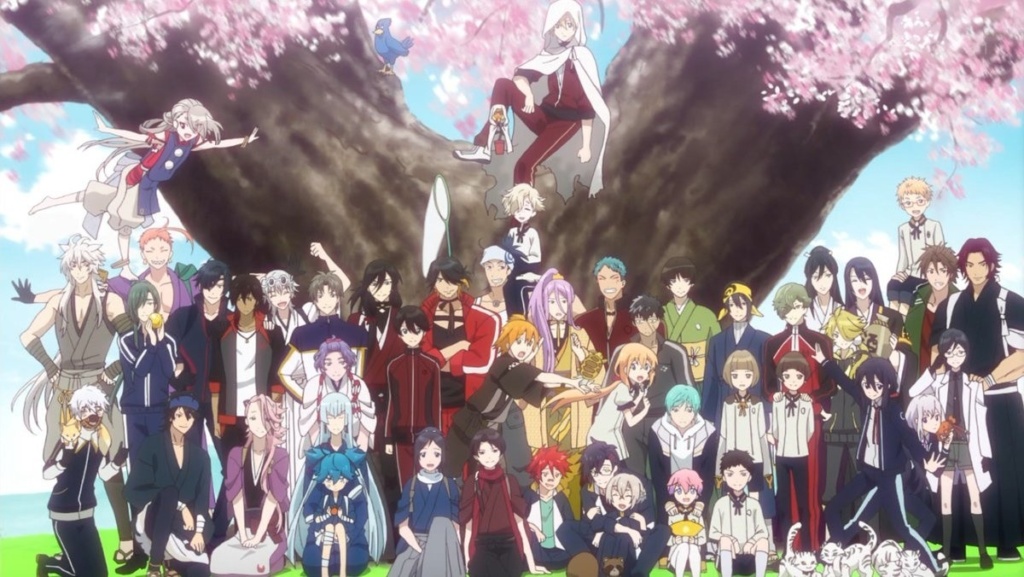
Touken Ranbu is set in the future, the year 2205, when the “Historical Retrograde Army” has used time-traveling tech to attack past events and try to alter history. The unseen Saniwa, tasked with protecting history, has the ability to bring objects to life. The best of them are Japan’s historical weapons. Token Danshi are legendary weapons brought to life to help keep history safe.
While the premise is primarily action-based, and it does have its Samurai X moments. One of which is the revisited Ikedaya Incident, known among Japanese historians and samurai anime fans as the clash between the Shinsengumi and the activists employed by the Choshu and Tosa clans. Aside from that, it’s an idyllic slice of life series that shows these flower men living together in the Citadel while waiting for their next mission. Take note that these swords are actual, historical weapons. Some of them are kept safe in shrines and government warehouses in Japan.
Needless to say, its Hana Yori Dango-ish appeal has made the original game very popular in Japan, especially among women, with more than 1.5 million active players by 2016. Furthermore, the game has been credited with the rise of the katana joshi subculture, ladies enthusiastic about historical Japanese swords.
There were two other anime adaptations: Katsugeki Touken Ranbu in 2017 and Zoku Touken Ranbu: Hanamaru in 2018.
25. Carried by the Wind: Tsukikage Ran (Kazemakase Tsukikage Ran) (2000)
MAL Score: 7.12
Carried by the Wind is one of those rare entries that thrives in simplicity. It does not try to be ambitious, where a lot of entries have tried and failed. Instead, in its straightforward narration and episodic format, it manages to pull off a refreshing 13-episode adventure in the expansive samurai anime genre.

Tsukikage Ran follows the sake-loving, masterless samurai (ronin, yes) who goes “wherever the wind takes her.” Yes, the MC is a badass female samurai, with her Chinese martial artist companion Miao. Usually, Miao butts in other people’s business, helping people in distress and putting her in conflict with the city’s villains. Ran then bails her out and often leads to the climax fight scene.
It has a few counterintuitive points that work in its favor. If you’ve noticed the use of rock or city pop style music in other entries in this list, Tsukikage Ran does not. It has one of those traditional Japanese songs, complete with the old-style singing. It sets the moods, together with a montage of Ran’s peaceful life. As for the fight scenes, both Ran and Miao carry their weights in the series, formidable fighters in their own right. While it does not have a Big Bad villain, it does introduce us to a variety of bandits and evil people who disrupt the otherwise peaceful countryside life. Ran is basically your female, non-emo Kenshin Himura.
The title also perfectly summarizes the show, nothing grand and anywhere goes. This does not create any increasing tension over the series, allowing you to just breeze through the episodes. This entry serves as a great recommendation for fans looking for a brief respite from their usual anime watch sessions.
26. One Piece (Wano Arc) (2019)
MAL Score: 8.51
To be fair, the MAL Score reflected here is for the series as a whole. Also, as a fan of the series when it first came out, you know we’ll find ways to get One Piece whenever possible. The Shonen titan almost has it all – a healthy dose of fighting and even a body swapping arc. If we would even include the Nissin Cup Noodle commercial, One Piece could qualify as a slice of life anime.
Anyways, the Wano Arc is the token Japanese culture arc of One Piece, starting in 2019 for the anime. The isolated land of the fabled samurai is the main setting of the Strawhats war against Kaidou of the Four Emperors. Essentially, this is the climax of the adventures starting from their entry into the New World. With the ragtag alliance that Law and Luffy have formed, they face one of the most frightening pirates around. Furthermore, it also explains how pirates have invaded the isolated nation and discloses the background for their new allies – the samurai!
One of the most striking features of the One Piece Wano Arc as a samurai anime is the visuals. From the waters surrounding the nation that looks like those ukiyo-e woodblock prints to the look of the samurai, Oda-sensei pulls no punches. While One Piece has established a reputation for crazy character designs that only work in his world. As a samurai anime, the animation team from Toei Philippines deserves recognition for the consistent movie-like quality every episode. No offense for Naruto and Nanatsu no Taizai fans, but this is consistency right here.
A Modern Twist on the Samurai Revenge
The main storyline in the Wano Arc is the rightful heir and the loyal attendants who live only to take revenge for their deceitfully killed master. Imagine, the seeds of this modern 47 Ronin-esque story were first sown with the introduction of Kin’emon back in the 580th episode, which aired back in 2013. From Punk Hazard, to Dressrosa, Zou, Whole Cake, and now to Zou. This slow build-up without suffering in terms of animation style and narration probably explains the large hype as the war is now starting to escalate – with members of the Worst Generation facing up against Kaido, and Big Mom.
Furthermore, Oda-sensei seamlessly integrates Wano and its history as a part of the Pirate King’s travels. A flashback arc back to the prime of Roger and Whitebear serving as the intermission before the great war is also a smart move. It gives us a breather while offering a rich, samurai anime mini-series in between.
27. Angolmois: Genkou Kassenki (Angolmois: Record of Mongol Invasion) (2018)
MAL Score: 7.15
As with a lot of the anime we try to get you to watch, we can try to present Angolmois: Genkou Kassenki in comparison to more mainstream series. However, to do only that is a disservice to this hidden gem. Action-wise, it is the perfect marriage between samurai anime and period drama. To simplify it at the risk of inaccuracy, it’s the Arslan Senki of feudal Japan.
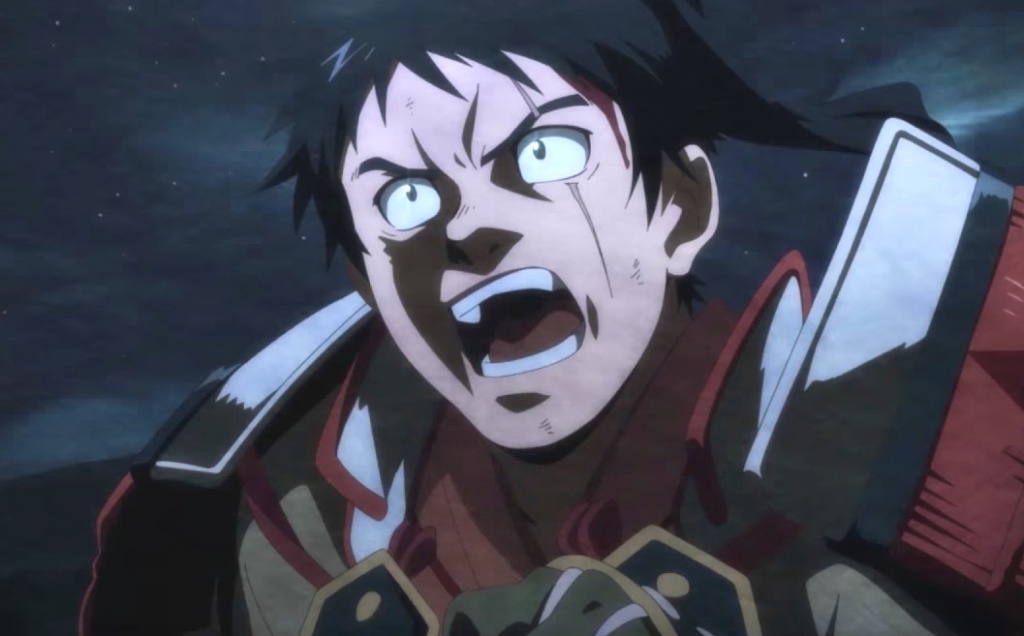
Angolmois: Genkou Kassenki follows a group of prisoners from the Japanese mainland sentenced to exile to Tsushima Island, which is located between Japan and Korea. The prisoners will serve as the expendable first line of defense against the invading foreigners – Mongolian and Goryeo (Korean) forces, with Jurchen tribes among them. The story is set in the historical first Mongol invasion of Japan, set in 1274.
Its entire story feels like a flashback, I feel that it’s caused by the animation style. You know it aims to create an authentic period drama sense, instead of the usual flashiness we find in action and shonen anime. Also, it might be late, but this is not for children. Angolmois does not hesitate in telling its story, unapologetic in the gore and the violence that must be the norm during the time of the Mongol invasion of Japan.
Also, in the middle of this ragtag group is the war veteran and samurai Kuchii Jinzaburou. He is not a hero, nor is he inherently malevolent, but he espouses a radical way of thinking. Jinzaburou is not bound by the samurai code. Instead, he fights for freedom, survival, and the thrill of the fight.
Good fights, solid character development, and strong roots in actual history – Angolmois is the hidden gem for the samurai anime genre. Also, the series is available on YouTube, legally.
28. Saber Marionette J (1996)
MAL Score: 7.35
It goes without saying that in this samurai anime list, the MC does not have to be a samurai or a ronin himself. Saber Marionette J is a good example of that. With a background that is a mix of futuristic and feudal Japan, Saber Marionette J occurs in a world much like those in Gintama, but with virtually no aliens and no… women?
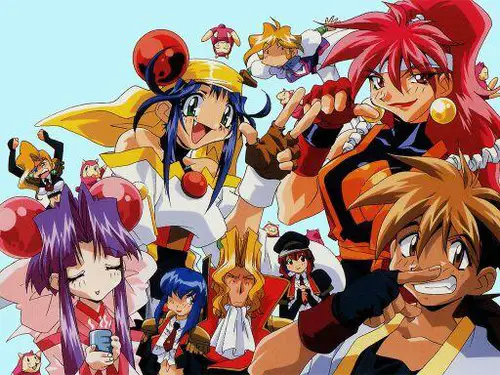
In Saber Marionette J, we are introduced to Otaru Mamiya. He is an 18-year-old worker in the city-state of Japoness (really?) on the womenless planet of Terra II. After a series of unfortunate events, he ends up in a secret underground basement and reactivates a marionette – feminine robots that perform a variety of tasks. Introducing herself as Lime, Otaru soon discovers that this is a unique marionette – capable of expressing human emotions.
While it generally appears like a sit-com kind of series, it actually explores some serious themes. The first and perhaps central to the story, is Otaru’s developing feelings of love and concern towards his marionette friends. At one point in the story, Mitsurugi lays down the discriminatory view towards marionettes: that they are not important to humans aside from the menial labor that they do, and that they don’t deserve affection from their human masters.
As a samurai anime, the fight scenes vary. Yes, we have the token traditional samurai in the form of Soemon Obiichi – Otaru’s master and a case of society shunning someone who “loved” a marionette. But make no mistake, he is like a more human version of Samurai X’s Seijuro Hiko. Also, Otaru later uses a jutte to fight. It is the weapon of policemen in Feudal Japan, similar to the one One Piece’s Smoker uses.
29. Yaiba (Kenyū Densetsu Yaiba) (1993)
MAL Score: 7.45
A light-hearted adventure and samurai anime for the whole family, Yaiba has been a regular treat for most of us (the slightly older people) growing up. It felt like the Detective Conan for samurai anime. This comparison makes it surprising since its anime only had 52 episodes, originally running from 1993 to 1994.
Also, Yaiba and Detective Conan are made by the same legend – Gosho Aoyama.
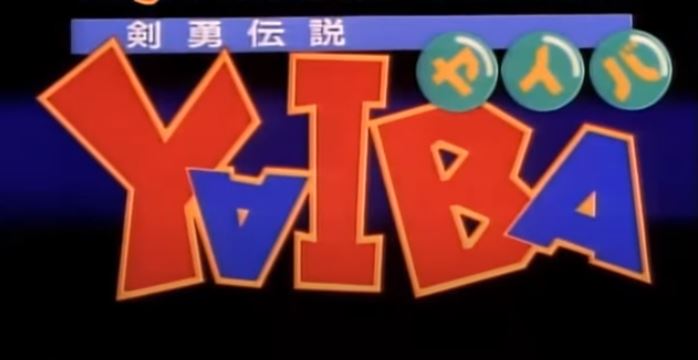
Yaiba follows the everyday fish out of the water adventures of Yaiba Kurogane, who seems to know nothing else aside from being a samurai in the forests. One day, he and his father escaped their attackers and were transported to the city. Here he discovers that he is a legendary warrior tasked to defend the world from evil, such as the horned high school student Takeshi Onimaru.
He is joined by the high school girl Sayaka Mine and is guided by a number of legendary samurai brought to modern times. Fearsome legends have been given crazy powers and even crazier personalities, making them light and funny add-ons to the series. Remembering my childhood viewing of this anime, the iconic tiger, giant frog, and vulture instantly came to mind. Giant animals and friends to the small Yaiba make for an insanely fun and colorful experience. Further down the story, however, the enemies grow larger and more powerful. Two of them, especially the Underworld Boss and the Yamata no Orochi, give off epic Dragon Quest vibes for the 5-year-old kid in me back then.
Also, the Yaiba and Detective Conan crossovers are a fun binge-watching break to catch. Make sure to see it at least once in your life.
30. Bakumatsu Kikansetsu Irohanihoheto (Intrigue in the Bakumatsu: Irohanihoheto) (2006)
MAL Score: 7.12
A story set in the Bakumatsu – the last years of the Shogunate – with a fantasy theme to it is a concept that feels so overused and overextended. That’s why finding a good samurai anime with this particular formula tends to fall on a short list. With the historical sense of Rurouni Kenshin minus the flamboyance of Sengoku Basara, Bakumatsu Kikansetsu Irohanihoheto is a must-watch for people looking for a serious watch, with equal parts supernatural, conspiracies, and good old samurai slashing.
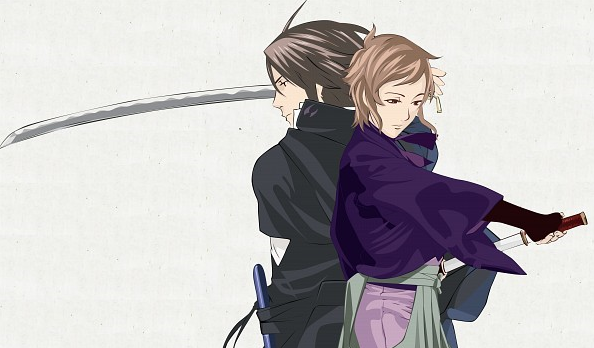
It follows the seventeen-year-old (believe it) Yojiro Akizuki, an assassin who holds the legendary Getsuruito. He is tasked with destroying a mysterious object known as the Head of the Conqueror, which heralds unrest and trouble. During his search, he encounters a traveling kabuki group whose members eventually reveal their own, individual agendas and motivations.
It starts cool, dark, and mysterious before apparently slowing down, Yojiro working with the Troupe. However, a little later on in the story the conspiracy within the dying Shogunate and the different warlords starts to unfold. I find it interesting because the story not only leans on the supernatural powers these players have but on the scheming and deceitful minds of those controlling the events across the land.
Lastly, its swordfights range from the traditional fight between humans to something like a watered-down Bleach. Don’t get me wrong, it works perfectly well in the context of its story. It is one of those non-mainstream work, mainly because it was an ONA series, but still it deserves more attention.
Conclusion
So there you have it, our recommendation for the best Samurai anime – from flashy sword fights to careful inquisition of life and honor. While the Samurai are no longer around, the character archetype they have become continues to inspire cool and moving works.
What’s your favorite samurai anime? Have we missed anything? Let us know in the comments.

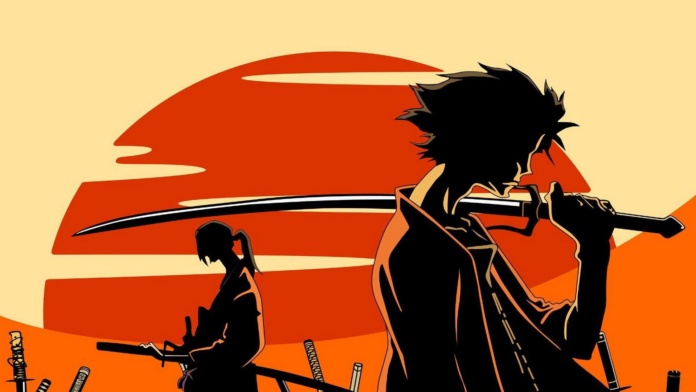
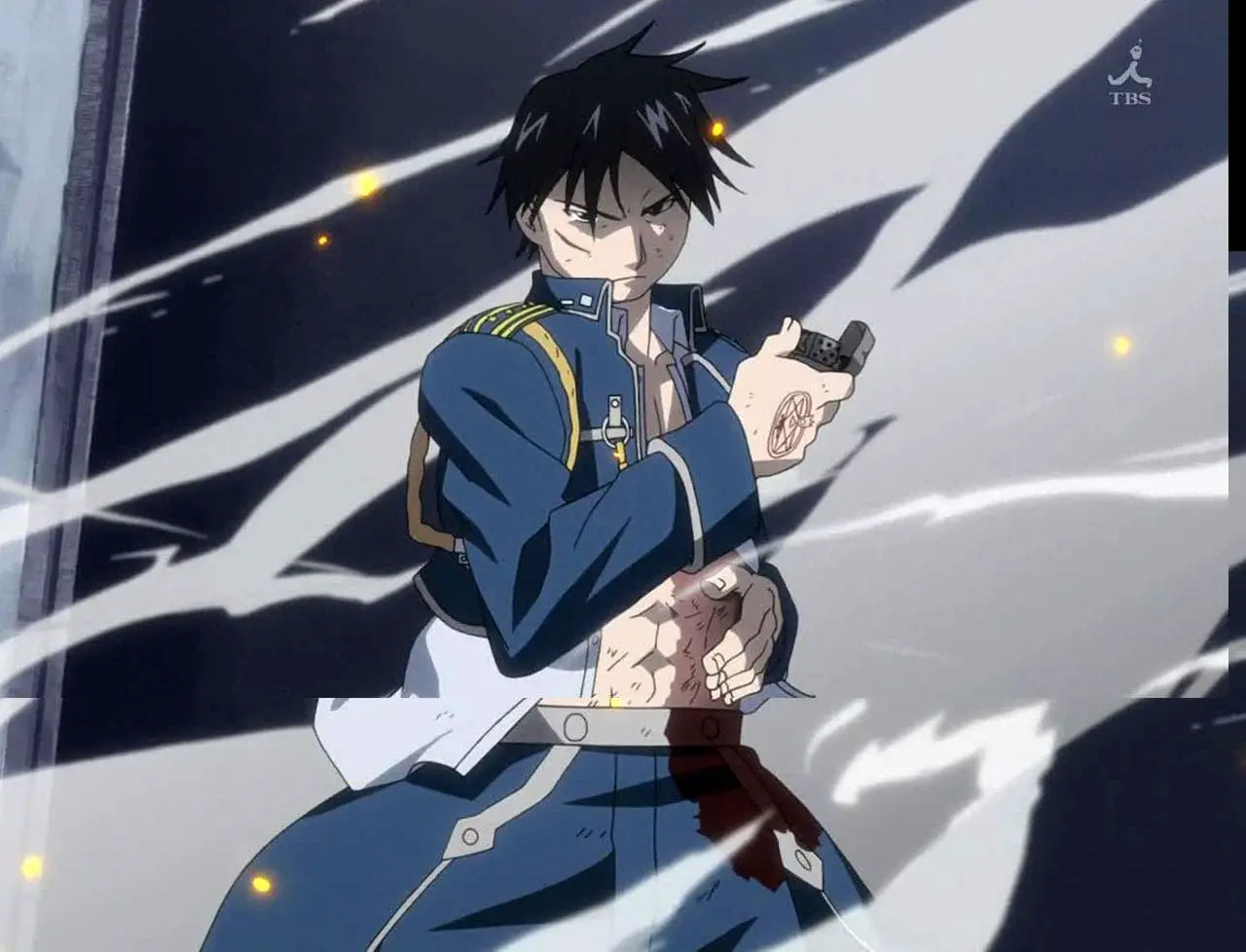
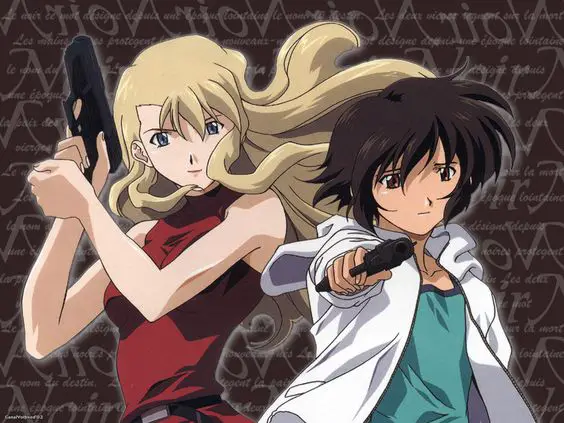
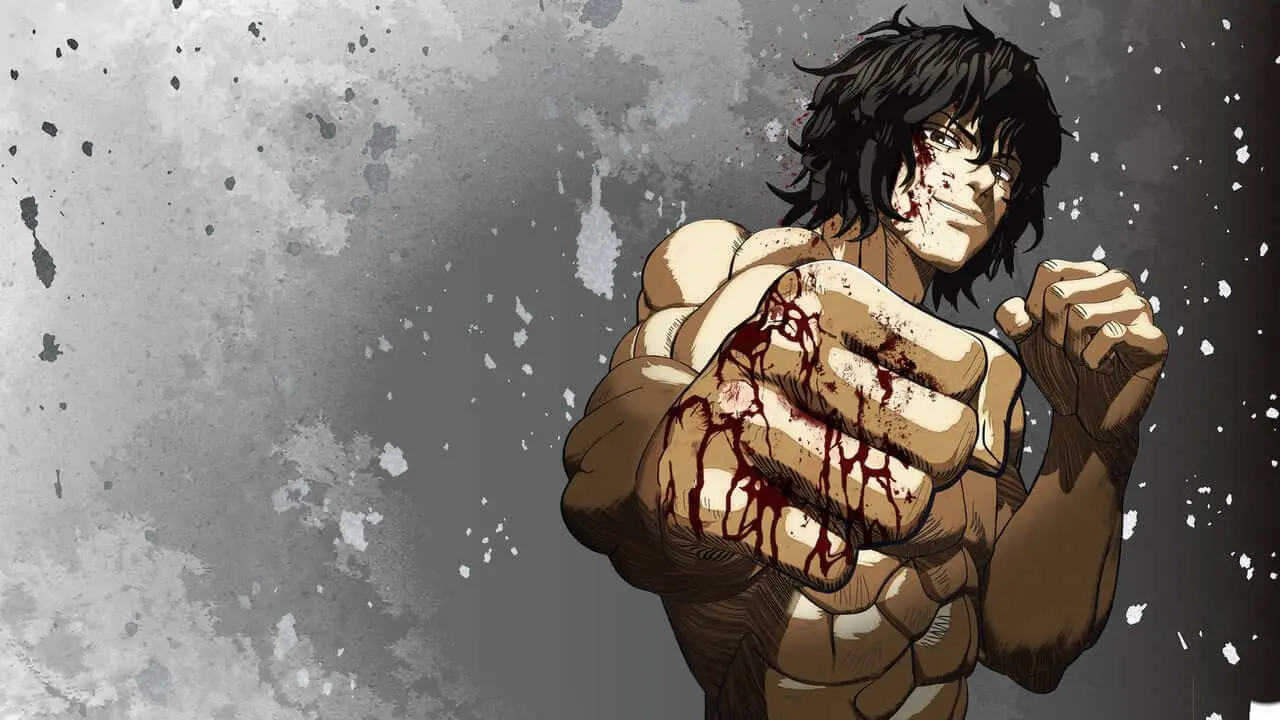


![What does Tanjiro’s black sword mean? [All Nichirin Sword Colors Explained]](https://chasinganime.com/wp-content/uploads/2020/01/Nichirin_Sword-100x70.png)
